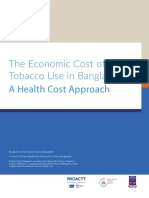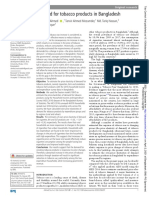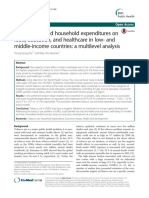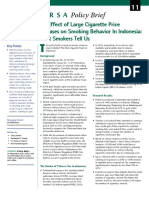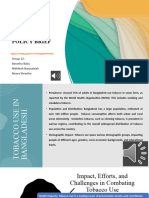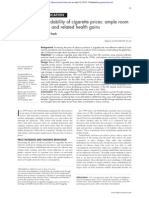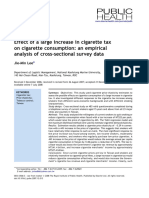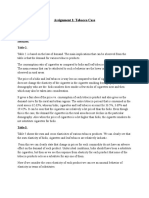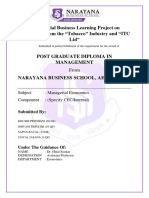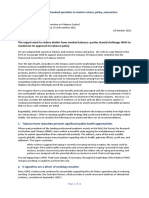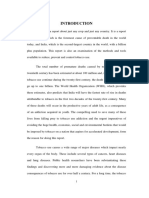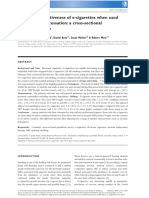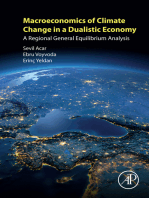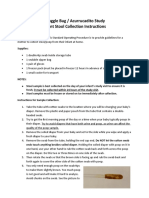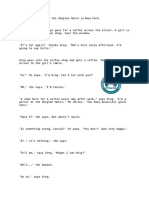Professional Documents
Culture Documents
Tobacco Consumption in Bangladesh An Analysis On Multiple Variables
Original Title
Copyright
Available Formats
Share this document
Did you find this document useful?
Is this content inappropriate?
Report this DocumentCopyright:
Available Formats
Tobacco Consumption in Bangladesh An Analysis On Multiple Variables
Copyright:
Available Formats
Volume 6, Issue 12, December – 2021 International Journal of Innovative Science and Research Technology
ISSN No:-2456-2165
Tobacco Consumption in Bangladesh:
An Analysis on Multiple Variables
Dr. Mostofa Mahmud Hasan BM Sajjad Hossain
Department of Business Administration Research Scholar, Faculty of Social Science
EXIM Bank Agricultural University Bangladesh University of Dhaka, Dhaka-1000, Bangladesh.
Abstract:- The World Health Organization [1] has Smoking cigarettes and bidis are really very common
estimated that more than eight million people died habits of all aged populations in Bangladesh. Not only that, a
worldwide every year from tobacco consumption. Most few hewing tobaccos like Zarda with betel quid or Gul are also
importantly, fifty percent of users died due to tobacco- commonly sold in Bangladeshi local markets, both in rural and
borne diseases and eighty percent of total users are from urban areas [3][4][5). The World Health Organization
lower-income countries. As part of fiscal policy, tax, as well analyzed the cost of tobacco consumption at the national level
as price increasing method, is considered the most effective and found it to be associated with increased healthcare costs,
way to reduce cigarette consumption in any nation. The loss of productivity due to illnesses and early deaths, and
Government of Bangladesh has tried to reduce tobacco environmental pollution [6].
consumption without hampering revenue collection from
tobacco tax. Consequently, the strategic decision had been The cheap and availability of tobacco products at any
taken to balance between those two factions over the years. place are the main cause of a huge number of consumers in
In this paper, all the data had been collected from Bangladesh. Nonetheless, the lack of strong tobacco control
secondary sources. A regression analysis had been regulations and weak enforcement of the existing regulations
conducted in the research to find out the relation between made the situation worse. The Global Adult Tobacco Survey
tobacco consumption with tobacco tax and education rate. conducted by WHO had reported that Bangladesh is one of the
It had been found that a higher tax rate and increased top ten countries in the world with high tobacco use (both
education rate had a negative impact on tobacco smoking and smokeless forms) with a prevalence of 43.3
consumption tendency in the context of Bangladesh. percent among adults where 1.5 percent of women engaged in
smoking [7].
Keywords:- Tobacco Consumption; Tobacco Tax in
Bangladesh; Education Rate; Tobacco Items; Health Tobacco is not only a harmful consumption item for
Hazards. human health but also a financial burden for a nation. A lot of
people die from tobacco-related illnesses every year around
I. INTRODUCTION the globe [8]. Both smoking tobacco (popular at a young age)
and smokeless tobacco (popular in middle age) create various
The tobacco industry in Bangladesh has passed its serious types of health hazards and environmental pollution.
glorious period since 1971 when the production of tobacco has
increased gradually. Between the years 1971 and 2010, the The government of Bangladesh has imposed a high level
total production of cigarettes has increased by 2.2 times while of taxes on tobacco products with an aim to reduce the
per capita availability of cigarettes has increased by 25 consumption tendency. As the education rate is increasing, the
percent. The share of GDP value of tobacco manufacturing habit of tobacco consumption would be reduced. An educated
compared to other sectors has increased from 5.44 percent in person bewares of the bad impact of tobacco use on health
1997 to 6.39 percent in 2010. Trends of the last three decades which may lead to a negative impression of tobacco
show that the share of gross value added by tobacco consumption. However, this paper has attempted to analyze
manufacturing has increased by 30 percent [2]. the relationship between tobacco consumption rate with
education rate and tax rate.
Bangladesh has been ranked as one of the top countries
around the world in terms of inflation rate which ranges II. LITERATURE REVIEW
between 7 to 9 percent. But compared to tobacco with our
necessity goods, tobacco is more expensive than many other [9] It had been observed that a decline in bidi (low-grade
necessity goods. Even cheap cigarette is expensive when cigarette) consumption can potentially contribute to the
compared to the many basic food items. The reality is that the growth in cigarette consumption through migration bidi to
price of a Gold leaf (most popular and well-branded) cigarette cigarette smoking habits by the new smokers. A sizable
is higher than the price of an egg. A pack of the Gold leaf is number of smokers use both cigarettes and bidi which has led
quite good enough that would be paid for two dozen eggs, for to exclusive cigarette smokers numbers. Based on this
three dozen small bananas, or for a liter of soybean oil (an research, it had been revealed that the number of exclusive
essential item for cooking). cigarette smokers increased by 2.7 million between 2009 and
2017 [10].
IJISRT21DEC265 www.ijisrt.com 266
Volume 6, Issue 12, December – 2021 International Journal of Innovative Science and Research Technology
ISSN No:-2456-2165
The researchers had discovered that tax earnings from C. Dependent variable
cigarettes is high but achievement in the healthcare sector is Smoking rate (15+) was used as dependent variable for
negligible that might be gained from reduction in cigarette this study.
consumption in Bangladesh. The research had observed the
change in overall tax structure and changes in cigarette taxes D. Independent Variable
and prices. It studied the consumption of different tobacco Education rate and tax on tobacco were used as
products between the years 2009 and 2017 after examining independent variables.
both the demand and supply-side factors in the cigarette
market in Bangladesh. E. Multiple Linear Regression
The multiple linear regression model is applied to
Tax structure in Bangladesh had been studied [11] and determine the relationship between a dependent variable and
found multi-tiered complex excise. The research had found one or more independent variables. The general form of the
that the complexity of the cigarette market is different and the regression model is
widening price differential among brands is mainly 𝑦 = 𝛽0 + 𝛽1 𝑥1 + 𝛽2 𝑥2 + 𝛽3 𝑥3 + … + 𝛽𝑘 𝑥𝑘 + 𝜀 (1)
responsible for this. Demand for cigarettes has been increasing
in the last few years due to this market structure with respect Where 𝑦 the dependent is variable, 𝛽0 is the intercept,
to price, quality, and branding. x1 to xk are the independent variables, β1 to βk is the change
in 𝑦 for each one increment change in the independent
British American Tobacco recognized the role of volume variables, and ɛ is the disturbances. Therefore, the ordinary
growth in spurring higher portability, alongside the least square fitted model from (1) is given by
contributions of the better brand mix, price increases by
𝑦̂ = 𝛽̂0 + 𝛽̂1 𝑥1 + 𝛽̂2 𝑥2
government order, cost savings, and productivity growth.
British American Tobacco from cigarette sales 121% higher
𝑦̂is the predicted value of the dependent variable𝑦, 𝛽̂0 is
compared between 2009 and 2016, from 3.84 to 8.47 billion
BDT in between 2009 and 2018 prices [12]. Research had been the intercept, x1 to x2 are the independent variables, 𝛽̂1 𝑡𝑜 𝛽̂2
associated and from there it had been suggested that an is the estimated value of β1 to β2.
increase in the affaffordability of cigarettes relative to bidis has
driven this migration of bidi smokers to cigarettes [13]. Since the variables are measured in different units, so we
used standardized partial regression coefficients which is
Tobacco is one of the leading causes of disability and measured by
death around the globe. Over a million pounds of toxic 𝑠𝑘
chemicals are released by tobacco products. [14] It had been 𝛽̂𝑘 =
studied to explore the effects of tobacco toxicants on human 𝑠𝑦
health and environmental pollution. The study had assessed
the knowledge about toxicant content in tobacco and the health Where, 𝑠𝑘 is the standard deviation of the
and environmental hazards of tobacco use. k’th independent variable and 𝑠𝑦 is the standard deviation of
the dependent variable.
A few researches have been found on the tobacco
industry that discussed consumption rate with its related other IV. RESULTS AND DISCUSSION
factors. Mostly are about the consumer categories, user
preference, market share, probability of the firms, brand There are numerous macroeconomic variables that affect
available in the market, etc. This paper has found this gap and Smoking rate. Here, we used some selected variables which
conducted a regression analysis of tobacco consumption rate are given in table 1. Where it is observed that with the passes
with education rate and tobacco tax rate settled by the of the year smoking rate is declining, on the contrary, tax rate
government. on tobacco increasing and education rate is increasing day by
day.
III. METHODOLOGY
A. Graphical Analysis
A. Data Source Figure 1 clearly demonstrate that throughout the
The researchers used secondary data related to this study considered period smoking rate curve has been declining, on
and data for the fiscal year 2007-08 to 2019-2020. the other hand, tax rate curve and education rate curve are in
upward move, implying that there exists a negative relation
B. Data Analysis Techniques between dependent and independent variables.
The secondary data has been analyzed in SPSS 16.00
version and descriptive statistics and multiple linear regression
was used to analyze the effect of the variables.
IJISRT21DEC265 www.ijisrt.com 267
Volume 6, Issue 12, December – 2021 International Journal of Innovative Science and Research Technology
ISSN No:-2456-2165
Smoking Tax Rate on Education In figure 2, it is observed that day by day tax rate is
Year increasing and smoking rate in decreasing.
Rate (15+) Tobacco Rate
80.00
2007-08 45.50 49.00 46.66
2008-09 45.00* 49.00 49.00* 70.00
2009-10 44.00* 49.00 52.00* 60.00
Smoking
2010-11 43.50 50.00 56.00* 50.00 Rate (15+)
*
2011-12 43.00 52.25 58.77 40.00
2012-13 42.30 53.75 57.86 30.00
2013-14 41.70* 53.75 61.02
20.00
2014-15 41.10 56.25 61.09 Eduacatio
*
10.00
2015-16 40.60 58.75 65.14 n Rate
0.00
2016-17 40.10 60.00 72.76
*
2017-18 39.60 61.25 72.89
2018-19 39.10 62.50 73.91
2019-20 38.00 *
62.50 74.68 Fig 3: Scatter plot of smoking Rate (15+) and education rate
Table 1: Smoking Rate (15+), tax rate on tobacco and in Bangladesh from 2007-08 to 2019-20
education rate in Bangladesh from 2007-08 to 2019-20 Source: Authors calculation from collected data
Source: [15] & [16] * used simple forecasting method
Figure 3 indicates that smoking rate gradually decreased
with increasing education rate.
80.00
70.00 Tax Rate on C. Correlation Analysis
Tobacco
60.00
50.00 Factors Pearson r
40.00 Tax rate on tobacco -0.973
30.00 Eduacation Education rate -0.975
Rate Table 2: Correlation of tax rate on tobacco and education
20.00
rate with smoking Rate (15+)
10.00
Source: Authors calculation from collected data
0.00
Smoking
2012-13
2019-20
2007-08
2008-09
2009-10
2010-11
2011-12
2013-14
2014-15
2015-16
2016-17
2017-18
2018-19
Rate (15+) Table 2 reveals that both tax rate on tobacco and
education rate are very close to perfect negatively correlated
with the dependent variable smoking rate. That is, with the
Fig 1: Scatter plot of smoking Rate (15+), tax rate on tobacco increasing of the tax rate on tobacco and education rate
and education rate in Bangladesh from 2007-08 to 2019-20 smoking rate decreases.
Source: Authors calculation from collected data
D. Multiple Linear Regression Model For Smoking Rate
70.00
60.00
Sources of F P
DF SS MS
Tax Rate on Variation value value
50.00 Regression 2 62.36 31.183 130.79 .000
Tobacco
40.00 5 4
Residual 10 2.384 .238
30.00
Total 12 64.74
20.00 9
10.00 Table 3: Testing overall significance of the regression model
Smoking Source: Authors calculation from collected data
0.00 Rate (15+)
2010-11
2014-15
2007-08
2008-09
2009-10
2011-12
2012-13
2013-14
2015-16
2016-17
2017-18
2018-19
2019-20
Table 3 explains that tax rate on tobacco and education
rate are jointly significant with smoking rate at 5% level of
significance.
Fig 2: Scatter plot of smoking Rate (15+) and tax rate on
tobacco in Bangladesh from 2007-08 to 2019-20
Source: Authors calculation from collected data
IJISRT21DEC265 www.ijisrt.com 268
Volume 6, Issue 12, December – 2021 International Journal of Innovative Science and Research Technology
ISSN No:-2456-2165
95% CI
Sources of Variation Coefficients Std. Error t value P value
Lower Upper
Intercept 60.732 2.635 23.049 .000 54.861 66.603
Education Rate -.130 .060 -2.150 .057 -.265 .005
Tax rate on tobacco -.198 .110 -1.792 .103 -.443 .048
Table 4: Testing individual significance of the regression model
R = 0.981, R2 = 0.963 and R2adj = 0.956
Source: Authors calculation from collected data
From the table 4, the estimated model for Smoking Rate public vehicles. However, still, there is an option to increase
is, the tax rate on tobacco products, for both importation and
purchase. As education builds the nation by creating
̂ 𝑅𝑎𝑡𝑒 = 60.732 − .130𝐸𝑑𝑢𝑐𝑎𝑡𝑖𝑜𝑛 𝑅𝑎𝑡𝑒
𝑆𝑚𝑜𝑘𝑖𝑛𝑔 awareness. It is also found that a higher education rate has led
− 0.198𝑇𝑎𝑥 𝑅𝑎𝑡𝑒 𝑜𝑛 𝑇𝑜𝑏𝑎𝑐𝑐𝑜 to having a reduction in tobacco consumption in the context of
the Bangladeshi tobacco market. Threfore, we should be more
Education rate is negatively associated with Smoking tactful in setting policy to increase education rate as well as
rate and the coefficient -.130 indicates that one standard Cigarette tax rates should have been set at an optimal level to
deviation increase in education rate would lead to .130 help limit tobacco consumption.
standard deviation decrease in smoking rate.
REFERENCES
Tax rate on tobacco is also negatively associated with
Smoking rate and the coefficient -0.198 indicates that one [1]. World Health Organization (WHO). World Health
standard deviation (increase) change in tax rate on tobacco Statistics 2021 (Monitoring Health for the SDGs) 2021.
would lead to 0.198 standard deviation decrease in Smoking [2]. American Urological Association (AUA) Annual
rate. Scientific Report May 14 - 19, 2011; Washington, DC,
2011
All the independent variables (Education rate and tax rate [3]. Choudhury, K., Hanifi, S.M.A., Mahmood, S.S., Bhuiya,
on tobacco) are statistically significant at 5% level of A., Sociodemographic characteristics of tobacco
significance. That means, Education rate and tax rate on consumers in a rural area of Bangladesh. J Health Popul
tobacco jointly influence on smoking rate but individually they Nutr, 25: 456-464, 2007.
are not significant at 5% level of significance. [4]. Khan, M.M.H., Khandoker, A., Kabir, M.A., Kabir, M.,
Mori, M.,. Tobacco consumption and its association with
Adjusted R-square value 0.956 indicates that 95.6%% of illicit drug use among men in Bangladesh. Addiction,
the total variation of smoking rate is explained by the 101: 1178-1186, 2006.
education rate and tax rate on tobacco, i.e., this model is very [5]. Rahman, M., Chowdhury, A.S., Fukui, T., Hira, K.,
good enough in predicting the dependent variable smoking Shimbo, T. Association of thromboangiitis obliterans
rate. with cigarette and bidi smoking in Bangladesh: a case-
control study. Int J Epidemiol, 29: 266-270, 2000.
Conclusively, both the independent variables (tax rate on [6]. World Health Organization (WHO). Impact of tobacco-
tobacco and education rate) show joint negative effect on the related illnesses in Bangladesh. Dhaka: World Health
dependent variable (smoking rate), that means with increasing Organization, 2005.
tax rate on tobacco and education rate, the smoking rate is [7]. Global Adult Tobacco Survey (GATS). World Health
decreasing. But individually single variable (none of those two Organization and Government of the People’s Republic
variables) is not being significant enough to influence on of Bangladesh Joint Project. Dhaka, Bangladesh, 2009.
smoking rate. Therefore, from the study it may be concluded [8]. American Lung Association (ALA). Overall Tobacco
that to minimize the smoking rate, both tax rate on tobacco and Trends. a web post. Retrieved on 10 August 2021 from
education rate are to be increased day by day up to the optimal the web-side link:
level. https://www.lung.org/research/overall-tobacco-trends,
2020
V. CONCLUSION [9]. Nargis. N., Ruthbah, U.H., Hussain, A.K.M.G., Fong,
G.T., Huq, I., Ashiquzzaman, S.M. The price sensitivity
Tobacco consumption is highly dependent on the tax rate of cigarette consumption in Bangladesh: evidence from
and education. The research has found that a tax on tobacco the International Tobacco Control (ITC) Bangladesh
may control the market. The government is responsible to wave 1 (2009) and wave 2 (2010) surveys. Tobacco
introduce laws and regulations and for taking measures to Control. 2014 Mar;23 Suppl 1:i39–47. doi:
enforce the laws regarding any harmful issues. In the context 10.1136/tobaccocontrol-2012-050835 PMID: 24105828,
of Bangladesh, the government wants to control the use of 2014.
tobacco but without hampering one of the largest sources of
revenue from this sector. Rules have been established for two
decades to reduce smoking in public places, especially on
IJISRT21DEC265 www.ijisrt.com 269
Volume 6, Issue 12, December – 2021 International Journal of Innovative Science and Research Technology
ISSN No:-2456-2165
[10]. Nargis, N., Hussain, A. K. M. G., Goodchild,
M., Quahd, A. C. K., & Fong, G. T. A decade of cigarette
taxation in Bangladesh: lessons learnt for tobacco
control. Bull World Health Organ. 97:221–229| doi:
10.2471/BLT.18.216135, 2019.
[11]. Shang C, Chaloupka FJ, Fong, G.T., Thompson, M,m
O’Connor, R.J. The association between tax structure
and cigarette price variability: Findings from the
International Tobacco Control Policy Evaluation (ITC)
Project. Tobacco Control. 0:1–6, 2015.
[12]. British American Tobacco (BAT) Bangladesh Company
Limited, Dhaka. Annual Reports-2010, 2016. Retrieved
on 31 May 2021 from the web-side link:
http://www.batbangladesh.com/group/sites/BAT_9T5F
Q2.nsf/vwPagesWebLive/DOA53FZC 2011, 2017.
[13]. Nargis, N. Stoklosa, M., Drope, J., Fong, G.T., Quah,
A.C.K., Driezen, P.,. Trend in the affordability of tobacco
products in Bangladesh: findings from the ITC
Bangladesh Surveys. Tobacco Control. 2018 Apr
19;tobaccocontrol-2017-054035.
doi:10.1136/tobaccocontrol-2017-054035
PMID:29674513, 2018.
[14]. Mondol, MA., Hosain, ANM., Sultana, S., Marzia, S.,
Islam, M.A., Mahmud, H.M.M., Biswash, P. Impact of
common tobacco products on human health and
environmental pollution in Bangladesh. Progressive
Agriculture 31 (3): 130-143, 2020 ISSN: 1017 – 8139,
2020.
[15]. World Bank. Bangladesh: Overview of Tobacco Use,
Tobacco Control Legislation, and Taxation-A Country
Brief, WBG, 2019, p. 11-19
[16]. Barkat, A., Chowdhury, A.U., Nargis, N., Rahman. M.,
Kumar, P.K.A., Bashir, S., Chaloupka, F.J., The
Economics of Tobacco and Tobacco Taxation in
Bangladesh. Paris: International Union Against
Tuberculosis and Lung Disease, 2012.
IJISRT21DEC265 www.ijisrt.com 270
You might also like
- SBST3203 Elementary Data AnalysisDocument8 pagesSBST3203 Elementary Data AnalysisSimon RajNo ratings yet
- Product Training FaceRealityDocument113 pagesProduct Training FaceRealityJazz100% (1)
- In Re Sars-Cov-2 Verified Complaint Jury Trial DemandedDocument64 pagesIn Re Sars-Cov-2 Verified Complaint Jury Trial DemandedSarah Westall100% (2)
- Bangladesh Health Cost Full Report 2020Document98 pagesBangladesh Health Cost Full Report 2020Jesse DanzigNo ratings yet
- Bangladesh Economics Report (3.21.22)Document65 pagesBangladesh Economics Report (3.21.22)Shabaz SharierNo ratings yet
- Does The Increase in The Cigarette Excise Tax Affect Cigarette Consumption?Document15 pagesDoes The Increase in The Cigarette Excise Tax Affect Cigarette Consumption?IJPHSNo ratings yet
- Effect of Cigarette Prices On Cigarette Consu 2022 Drug and Alcohol DependenDocument7 pagesEffect of Cigarette Prices On Cigarette Consu 2022 Drug and Alcohol Dependenirfan rizkiNo ratings yet
- Tobacco ProductsDocument7 pagesTobacco ProductsSAKIB MD SHAFIUDDINNo ratings yet
- Arun Kumar Term PaperDocument12 pagesArun Kumar Term PaperArun KumarNo ratings yet
- Fong Brian 272paperDocument28 pagesFong Brian 272paperDinda MaharaniNo ratings yet
- Price Elasticity of Demand For Cigarettes Among Youths in High-Income Countries A Systematic Review8Document9 pagesPrice Elasticity of Demand For Cigarettes Among Youths in High-Income Countries A Systematic Review8BoNo ratings yet
- Analyzing The Impact of Cigarette Pricing On Youth Smoking A Comparative Study of Nigeria and GhanaDocument4 pagesAnalyzing The Impact of Cigarette Pricing On Youth Smoking A Comparative Study of Nigeria and GhanaKIU PUBLICATION AND EXTENSIONNo ratings yet
- Tobacco Use and Household Expenditures On Food, Education, and Healthcare in Low - and Middle-Income Countries A Multilevel AnalysisDocument11 pagesTobacco Use and Household Expenditures On Food, Education, and Healthcare in Low - and Middle-Income Countries A Multilevel Analysisnoplayboy95No ratings yet
- In-and-Out of Tobacco Farming: Shifting Behavior of Tobacco Farmers in IndonesiaDocument16 pagesIn-and-Out of Tobacco Farming: Shifting Behavior of Tobacco Farmers in IndonesiaErica RyceNo ratings yet
- Team 3 Tobacco Taxation Economics AssignmentDocument5 pagesTeam 3 Tobacco Taxation Economics AssignmentBitan BanerjeeNo ratings yet
- The Effect of Cigarette SmokingDocument7 pagesThe Effect of Cigarette SmokingNerson Mozol100% (1)
- Accounting EstimatesniceDocument34 pagesAccounting EstimatesniceAnthony Tunying MantuhacNo ratings yet
- Price Elasticity Estimates For Tobacco and Other Addictive Goods in IndiaDocument28 pagesPrice Elasticity Estimates For Tobacco and Other Addictive Goods in IndiaG74GARV SETHINo ratings yet
- Policy Brief: The Effect of Large Cigarette Price Increases On Smoking Behavior in Indonesia: What Smokers Tell UsDocument2 pagesPolicy Brief: The Effect of Large Cigarette Price Increases On Smoking Behavior in Indonesia: What Smokers Tell Usmawar azzahraNo ratings yet
- Policy Brief PresentationDocument9 pagesPolicy Brief PresentationNoora ShresthaNo ratings yet
- Title F The Research Paper Tobacco Industry & GST Issues by Sk. Roshan 2018 Llb083 7Document28 pagesTitle F The Research Paper Tobacco Industry & GST Issues by Sk. Roshan 2018 Llb083 7Roshan ShakNo ratings yet
- Government Intervention in Cigarette Trade in AustraliaDocument6 pagesGovernment Intervention in Cigarette Trade in AustraliaTran Ngo Tra My (FGW DN)No ratings yet
- Cigarettesand Its Effectson HealthDocument10 pagesCigarettesand Its Effectson HealthAdarsh SharmaNo ratings yet
- Cigarettesand Its Effectson HealthDocument10 pagesCigarettesand Its Effectson HealthApurba JR DharuaNo ratings yet
- Ijerph 17 03327Document12 pagesIjerph 17 03327ardigumelar7ramadhanNo ratings yet
- Trends and Affordability of Cigarette Prices: Ample Room For Tax Increases and Related Health GainsDocument10 pagesTrends and Affordability of Cigarette Prices: Ample Room For Tax Increases and Related Health GainsEugenio MartinezNo ratings yet
- Implications of Tobacco Industry in India-Research and AnalysisDocument17 pagesImplications of Tobacco Industry in India-Research and AnalysisApurvAdarshNo ratings yet
- 2463 4477 1 PBDocument13 pages2463 4477 1 PBshovon mukitNo ratings yet
- Effect of A Large Increase in Cigarette Tax On Cigarette Consump 2008 PublicDocument7 pagesEffect of A Large Increase in Cigarette Tax On Cigarette Consump 2008 Publicirfan rizkiNo ratings yet
- Nihms 164629Document20 pagesNihms 164629muthurajmsmNo ratings yet
- Tobacco Case Assignment in EconomicsDocument8 pagesTobacco Case Assignment in EconomicsPriyankar PaulNo ratings yet
- Trends and Affordability of Cigarette Prices: Ample Room For Tax Increases and Related Health GainsDocument10 pagesTrends and Affordability of Cigarette Prices: Ample Room For Tax Increases and Related Health GainsEugenio MartinezNo ratings yet
- EIC ANALYSIS OF CIGARETTESDocument20 pagesEIC ANALYSIS OF CIGARETTESshivam tripathiNo ratings yet
- Who Cop9 Oct 2021 (Letter)Document11 pagesWho Cop9 Oct 2021 (Letter)Brent StaffordNo ratings yet
- Quiz Perpajakan 1 - Reishandra Sefa P - 2211031115Document4 pagesQuiz Perpajakan 1 - Reishandra Sefa P - 2211031115reishandrasNo ratings yet
- Rohan Project ReportDocument55 pagesRohan Project ReportshikhaNo ratings yet
- Bangladesh 2009 & 2017: Comparison FactDocument2 pagesBangladesh 2009 & 2017: Comparison FactAminul Islam SujonNo ratings yet
- Rethinking tobacco tax and price measures in BangladeshDocument7 pagesRethinking tobacco tax and price measures in BangladeshAriful IslamNo ratings yet
- Cigarettesand Its Effectson HealthDocument10 pagesCigarettesand Its Effectson Healthharichinraj2006No ratings yet
- Tobacco SripriyaDocument61 pagesTobacco SripriyaNithyababuNo ratings yet
- Smoke-Free Policies in The Global South: Nicotine & Tobacco Research October 2020Document3 pagesSmoke-Free Policies in The Global South: Nicotine & Tobacco Research October 2020Ankita RanaNo ratings yet
- Research Paper Cigarette TaxDocument5 pagesResearch Paper Cigarette Taxcafygq1m100% (1)
- The Effectiveness of Anti-Smoking Legislation: A ReviewDocument32 pagesThe Effectiveness of Anti-Smoking Legislation: A ReviewKarthik BhandaryNo ratings yet
- Global Economic Cost of Smoking-Attributable Diseases: Mark Goodchild, Nigar Nargis, Edouard Tursan D 'EspaignetDocument7 pagesGlobal Economic Cost of Smoking-Attributable Diseases: Mark Goodchild, Nigar Nargis, Edouard Tursan D 'EspaignetwachoNo ratings yet
- Proposed Tobacco Tax Structure - What Could Be AchievedDocument8 pagesProposed Tobacco Tax Structure - What Could Be AchievedJesse DanzigNo ratings yet
- Module 2Document2 pagesModule 2pavithran.sNo ratings yet
- IA EconomicsDocument3 pagesIA EconomicsElisa ElisaNo ratings yet
- Assessing the Role of Health Coaching in Tobacco CombatDocument10 pagesAssessing the Role of Health Coaching in Tobacco CombatHaneenNo ratings yet
- DPC RP Poverty FinalDocument21 pagesDPC RP Poverty Finalnguyenngocminh87No ratings yet
- Tobacco and PovertyDocument2 pagesTobacco and Povertymuhammadtaimoorkhan100% (2)
- A Case-Control Study of Bidi Smoking and Bronchogenic CarcinomaDocument8 pagesA Case-Control Study of Bidi Smoking and Bronchogenic CarcinomaIrawanMarlyNo ratings yet
- GDP alone does not determine quality of lifeDocument10 pagesGDP alone does not determine quality of lifeMildred MeltonNo ratings yet
- Faktor Merokok D BangladeshDocument6 pagesFaktor Merokok D Bangladeshchormel70No ratings yet
- Health Policy Plan. 2008 John 200 9Document10 pagesHealth Policy Plan. 2008 John 200 9ssvmani1No ratings yet
- Should All Sorts of Tobacco Products Be Banned by Law? Why or Why Not?Document5 pagesShould All Sorts of Tobacco Products Be Banned by Law? Why or Why Not?masfiq Hossain100% (1)
- 10.0000@Www - mdpi.Com@Generic 3E0F88F1149DDocument20 pages10.0000@Www - mdpi.Com@Generic 3E0F88F1149DDaniNo ratings yet
- The Impact of Cigarette Excise Tax Policy On Tobacco Market and Clove Market in IndonesiaDocument7 pagesThe Impact of Cigarette Excise Tax Policy On Tobacco Market and Clove Market in IndonesiaBAYU KHARISMANo ratings yet
- Pacek Et Al 2018 Conceptual Framework For Understanding Tobaco UseDocument10 pagesPacek Et Al 2018 Conceptual Framework For Understanding Tobaco UseTania Karina Álvarez MendozaNo ratings yet
- Cigarette Tax Research PaperDocument7 pagesCigarette Tax Research Paperhjqojzakf100% (1)
- Real-World Effectiveness of E-Cigarettes When Used To Aid Smoking CessationDocument10 pagesReal-World Effectiveness of E-Cigarettes When Used To Aid Smoking CessationAsd EfgNo ratings yet
- 1421 3612 1 SMDocument12 pages1421 3612 1 SMAlma Fortuna KiranaNo ratings yet
- Artikel Kelompok 3 CopDocument10 pagesArtikel Kelompok 3 CopFarhan BaeNo ratings yet
- Macroeconomics of Climate Change in a Dualistic Economy: A Regional General Equilibrium AnalysisFrom EverandMacroeconomics of Climate Change in a Dualistic Economy: A Regional General Equilibrium AnalysisNo ratings yet
- Formulation and Evaluation of Poly Herbal Body ScrubDocument6 pagesFormulation and Evaluation of Poly Herbal Body ScrubInternational Journal of Innovative Science and Research TechnologyNo ratings yet
- Comparatively Design and Analyze Elevated Rectangular Water Reservoir with and without Bracing for Different Stagging HeightDocument4 pagesComparatively Design and Analyze Elevated Rectangular Water Reservoir with and without Bracing for Different Stagging HeightInternational Journal of Innovative Science and Research TechnologyNo ratings yet
- Explorning the Role of Machine Learning in Enhancing Cloud SecurityDocument5 pagesExplorning the Role of Machine Learning in Enhancing Cloud SecurityInternational Journal of Innovative Science and Research TechnologyNo ratings yet
- A Review: Pink Eye Outbreak in IndiaDocument3 pagesA Review: Pink Eye Outbreak in IndiaInternational Journal of Innovative Science and Research TechnologyNo ratings yet
- Design, Development and Evaluation of Methi-Shikakai Herbal ShampooDocument8 pagesDesign, Development and Evaluation of Methi-Shikakai Herbal ShampooInternational Journal of Innovative Science and Research Technology100% (3)
- Studying the Situation and Proposing Some Basic Solutions to Improve Psychological Harmony Between Managerial Staff and Students of Medical Universities in Hanoi AreaDocument5 pagesStudying the Situation and Proposing Some Basic Solutions to Improve Psychological Harmony Between Managerial Staff and Students of Medical Universities in Hanoi AreaInternational Journal of Innovative Science and Research TechnologyNo ratings yet
- A Survey of the Plastic Waste used in Paving BlocksDocument4 pagesA Survey of the Plastic Waste used in Paving BlocksInternational Journal of Innovative Science and Research TechnologyNo ratings yet
- Electro-Optics Properties of Intact Cocoa Beans based on Near Infrared TechnologyDocument7 pagesElectro-Optics Properties of Intact Cocoa Beans based on Near Infrared TechnologyInternational Journal of Innovative Science and Research TechnologyNo ratings yet
- Auto Encoder Driven Hybrid Pipelines for Image Deblurring using NAFNETDocument6 pagesAuto Encoder Driven Hybrid Pipelines for Image Deblurring using NAFNETInternational Journal of Innovative Science and Research TechnologyNo ratings yet
- Cyberbullying: Legal and Ethical Implications, Challenges and Opportunities for Policy DevelopmentDocument7 pagesCyberbullying: Legal and Ethical Implications, Challenges and Opportunities for Policy DevelopmentInternational Journal of Innovative Science and Research TechnologyNo ratings yet
- Navigating Digitalization: AHP Insights for SMEs' Strategic TransformationDocument11 pagesNavigating Digitalization: AHP Insights for SMEs' Strategic TransformationInternational Journal of Innovative Science and Research TechnologyNo ratings yet
- Hepatic Portovenous Gas in a Young MaleDocument2 pagesHepatic Portovenous Gas in a Young MaleInternational Journal of Innovative Science and Research TechnologyNo ratings yet
- Review of Biomechanics in Footwear Design and Development: An Exploration of Key Concepts and InnovationsDocument5 pagesReview of Biomechanics in Footwear Design and Development: An Exploration of Key Concepts and InnovationsInternational Journal of Innovative Science and Research TechnologyNo ratings yet
- Automatic Power Factor ControllerDocument4 pagesAutomatic Power Factor ControllerInternational Journal of Innovative Science and Research TechnologyNo ratings yet
- Formation of New Technology in Automated Highway System in Peripheral HighwayDocument6 pagesFormation of New Technology in Automated Highway System in Peripheral HighwayInternational Journal of Innovative Science and Research TechnologyNo ratings yet
- Drug Dosage Control System Using Reinforcement LearningDocument8 pagesDrug Dosage Control System Using Reinforcement LearningInternational Journal of Innovative Science and Research TechnologyNo ratings yet
- The Effect of Time Variables as Predictors of Senior Secondary School Students' Mathematical Performance Department of Mathematics Education Freetown PolytechnicDocument7 pagesThe Effect of Time Variables as Predictors of Senior Secondary School Students' Mathematical Performance Department of Mathematics Education Freetown PolytechnicInternational Journal of Innovative Science and Research TechnologyNo ratings yet
- Mobile Distractions among Adolescents: Impact on Learning in the Aftermath of COVID-19 in IndiaDocument2 pagesMobile Distractions among Adolescents: Impact on Learning in the Aftermath of COVID-19 in IndiaInternational Journal of Innovative Science and Research TechnologyNo ratings yet
- Securing Document Exchange with Blockchain Technology: A New Paradigm for Information SharingDocument4 pagesSecuring Document Exchange with Blockchain Technology: A New Paradigm for Information SharingInternational Journal of Innovative Science and Research TechnologyNo ratings yet
- Perceived Impact of Active Pedagogy in Medical Students' Learning at the Faculty of Medicine and Pharmacy of CasablancaDocument5 pagesPerceived Impact of Active Pedagogy in Medical Students' Learning at the Faculty of Medicine and Pharmacy of CasablancaInternational Journal of Innovative Science and Research TechnologyNo ratings yet
- Intelligent Engines: Revolutionizing Manufacturing and Supply Chains with AIDocument14 pagesIntelligent Engines: Revolutionizing Manufacturing and Supply Chains with AIInternational Journal of Innovative Science and Research TechnologyNo ratings yet
- Enhancing the Strength of Concrete by Using Human Hairs as a FiberDocument3 pagesEnhancing the Strength of Concrete by Using Human Hairs as a FiberInternational Journal of Innovative Science and Research TechnologyNo ratings yet
- Exploring the Clinical Characteristics, Chromosomal Analysis, and Emotional and Social Considerations in Parents of Children with Down SyndromeDocument8 pagesExploring the Clinical Characteristics, Chromosomal Analysis, and Emotional and Social Considerations in Parents of Children with Down SyndromeInternational Journal of Innovative Science and Research TechnologyNo ratings yet
- Supply Chain 5.0: A Comprehensive Literature Review on Implications, Applications and ChallengesDocument11 pagesSupply Chain 5.0: A Comprehensive Literature Review on Implications, Applications and ChallengesInternational Journal of Innovative Science and Research TechnologyNo ratings yet
- Teachers' Perceptions about Distributed Leadership Practices in South Asia: A Case Study on Academic Activities in Government Colleges of BangladeshDocument7 pagesTeachers' Perceptions about Distributed Leadership Practices in South Asia: A Case Study on Academic Activities in Government Colleges of BangladeshInternational Journal of Innovative Science and Research TechnologyNo ratings yet
- Advancing Opthalmic Diagnostics: U-Net for Retinal Blood Vessel SegmentationDocument8 pagesAdvancing Opthalmic Diagnostics: U-Net for Retinal Blood Vessel SegmentationInternational Journal of Innovative Science and Research TechnologyNo ratings yet
- The Making of Self-Disposing Contactless Motion-Activated Trash Bin Using Ultrasonic SensorsDocument7 pagesThe Making of Self-Disposing Contactless Motion-Activated Trash Bin Using Ultrasonic SensorsInternational Journal of Innovative Science and Research TechnologyNo ratings yet
- Natural Peel-Off Mask Formulation and EvaluationDocument6 pagesNatural Peel-Off Mask Formulation and EvaluationInternational Journal of Innovative Science and Research TechnologyNo ratings yet
- Beyond Shelters: A Gendered Approach to Disaster Preparedness and Resilience in Urban CentersDocument6 pagesBeyond Shelters: A Gendered Approach to Disaster Preparedness and Resilience in Urban CentersInternational Journal of Innovative Science and Research TechnologyNo ratings yet
- Handling Disruptive Behaviors of Students in San Jose National High SchoolDocument5 pagesHandling Disruptive Behaviors of Students in San Jose National High SchoolInternational Journal of Innovative Science and Research TechnologyNo ratings yet
- Bosh Reviewer MidtermsDocument8 pagesBosh Reviewer MidtermsGenie Rose Gonzales100% (1)
- Read The Following Text Written by Jacquie Mccarnan and Answer The Questions On The RightDocument1 pageRead The Following Text Written by Jacquie Mccarnan and Answer The Questions On The RightKarol Tatiana Ruiz Marquez100% (1)
- Severe Thrombocytopenia in A Child With Typhoid Fever - A Case Report - PMCDocument8 pagesSevere Thrombocytopenia in A Child With Typhoid Fever - A Case Report - PMCGita ParadiseNo ratings yet
- Views on Homelessness InterviewDocument80 pagesViews on Homelessness Interviewquin000000No ratings yet
- Provan and LemaireDocument12 pagesProvan and LemaireJaviera Vargas MorenoNo ratings yet
- Pengaruh Latihan Range of Motion (ROM) Ankle Terhadap Pencegahan Terjadinya Neuropati Dan Angiopati Pada Klien Diabetes MelitusDocument7 pagesPengaruh Latihan Range of Motion (ROM) Ankle Terhadap Pencegahan Terjadinya Neuropati Dan Angiopati Pada Klien Diabetes MelitusRafly PrasetyoNo ratings yet
- SAQ 1 PrelimDocument1 pageSAQ 1 PrelimEzekiel MarinoNo ratings yet
- Unidade 1 Texto: Know Your Brain: Mirror Neurons - SIMULADODocument2 pagesUnidade 1 Texto: Know Your Brain: Mirror Neurons - SIMULADOJoseano SouzaNo ratings yet
- Lecture 3 Orientation and Alignment - Starting With TheoryDocument17 pagesLecture 3 Orientation and Alignment - Starting With TheoryLuQmanulhafiz RamliNo ratings yet
- Biosample Stool Collection Protocol InfantDocument2 pagesBiosample Stool Collection Protocol Infantapi-531349549No ratings yet
- Health Teaching PlanDocument1 pageHealth Teaching PlanRheeanne AmilasanNo ratings yet
- Thesis Shourya PPT 2 3Document24 pagesThesis Shourya PPT 2 3Y ShouryaNo ratings yet
- Epicel Coding Guide PP - US.EPI.0024 PDFDocument28 pagesEpicel Coding Guide PP - US.EPI.0024 PDFEsq. Nelson OduorNo ratings yet
- Course Description: Biology 1001A (Biology For Sciences I) Fall 2019 Course Outline SummaryDocument3 pagesCourse Description: Biology 1001A (Biology For Sciences I) Fall 2019 Course Outline SummaryJJNo ratings yet
- The Girl With Green Eyes by John EscottDocument10 pagesThe Girl With Green Eyes by John EscottAyman Charoui essamadiNo ratings yet
- Suicide Awareness and PreventionDocument4 pagesSuicide Awareness and PreventionKeerthi RajpurohitNo ratings yet
- Safety Data Sheet: Dyestone Printgen XA-301Document4 pagesSafety Data Sheet: Dyestone Printgen XA-301unisourcceeNo ratings yet
- What Is A Lobotomy, History, Uses and SummaryDocument8 pagesWhat Is A Lobotomy, History, Uses and SummaryHussain AfzalNo ratings yet
- Chevening Scholarship ApplicationDocument4 pagesChevening Scholarship ApplicationMary Alabi100% (1)
- Medik8 - HyperpigmentationDocument8 pagesMedik8 - HyperpigmentationMustika Dwi SusilowatiNo ratings yet
- Manage Pneumonia through Appropriate Nursing InterventionsDocument1 pageManage Pneumonia through Appropriate Nursing InterventionsNora BacolNo ratings yet
- Junal ScreeningDocument9 pagesJunal ScreeningRama BayuNo ratings yet
- CIR example and antibiotic questionsDocument3 pagesCIR example and antibiotic questionsHafshah AgustinaNo ratings yet
- Resilience Theory ImplentationDocument64 pagesResilience Theory Implentationirawan saptonoNo ratings yet
- Finite Element Analysis of Occlusal Splint Therapy in Patients With BruxismDocument9 pagesFinite Element Analysis of Occlusal Splint Therapy in Patients With Bruxismwirda yunita darwisNo ratings yet
- Pfizer Remakes the CompanyDocument2 pagesPfizer Remakes the CompanyAlbert UmaliNo ratings yet
- General Risk Assessment FlowchartDocument18 pagesGeneral Risk Assessment FlowchartMohamad Nazmi Mohamad RafianNo ratings yet



